Zeyue Xue
RewardDance: Reward Scaling in Visual Generation
Sep 10, 2025Abstract:Reward Models (RMs) are critical for improving generation models via Reinforcement Learning (RL), yet the RM scaling paradigm in visual generation remains largely unexplored. It primarily due to fundamental limitations in existing approaches: CLIP-based RMs suffer from architectural and input modality constraints, while prevalent Bradley-Terry losses are fundamentally misaligned with the next-token prediction mechanism of Vision-Language Models (VLMs), hindering effective scaling. More critically, the RLHF optimization process is plagued by Reward Hacking issue, where models exploit flaws in the reward signal without improving true quality. To address these challenges, we introduce RewardDance, a scalable reward modeling framework that overcomes these barriers through a novel generative reward paradigm. By reformulating the reward score as the model's probability of predicting a "yes" token, indicating that the generated image outperforms a reference image according to specific criteria, RewardDance intrinsically aligns reward objectives with VLM architectures. This alignment unlocks scaling across two dimensions: (1) Model Scaling: Systematic scaling of RMs up to 26 billion parameters; (2) Context Scaling: Integration of task-specific instructions, reference examples, and chain-of-thought (CoT) reasoning. Extensive experiments demonstrate that RewardDance significantly surpasses state-of-the-art methods in text-to-image, text-to-video, and image-to-video generation. Crucially, we resolve the persistent challenge of "reward hacking": Our large-scale RMs exhibit and maintain high reward variance during RL fine-tuning, proving their resistance to hacking and ability to produce diverse, high-quality outputs. It greatly relieves the mode collapse problem that plagues smaller models.
Scaling Law for Quantization-Aware Training
May 20, 2025Abstract:Large language models (LLMs) demand substantial computational and memory resources, creating deployment challenges. Quantization-aware training (QAT) addresses these challenges by reducing model precision while maintaining performance. However, the scaling behavior of QAT, especially at 4-bit precision (W4A4), is not well understood. Existing QAT scaling laws often ignore key factors such as the number of training tokens and quantization granularity, which limits their applicability. This paper proposes a unified scaling law for QAT that models quantization error as a function of model size, training data volume, and quantization group size. Through 268 QAT experiments, we show that quantization error decreases as model size increases, but rises with more training tokens and coarser quantization granularity. To identify the sources of W4A4 quantization error, we decompose it into weight and activation components. Both components follow the overall trend of W4A4 quantization error, but with different sensitivities. Specifically, weight quantization error increases more rapidly with more training tokens. Further analysis shows that the activation quantization error in the FC2 layer, caused by outliers, is the primary bottleneck of W4A4 QAT quantization error. By applying mixed-precision quantization to address this bottleneck, we demonstrate that weight and activation quantization errors can converge to similar levels. Additionally, with more training data, weight quantization error eventually exceeds activation quantization error, suggesting that reducing weight quantization error is also important in such scenarios. These findings offer key insights for improving QAT research and development.
DanceGRPO: Unleashing GRPO on Visual Generation
May 12, 2025Abstract:Recent breakthroughs in generative models-particularly diffusion models and rectified flows-have revolutionized visual content creation, yet aligning model outputs with human preferences remains a critical challenge. Existing reinforcement learning (RL)-based methods for visual generation face critical limitations: incompatibility with modern Ordinary Differential Equations (ODEs)-based sampling paradigms, instability in large-scale training, and lack of validation for video generation. This paper introduces DanceGRPO, the first unified framework to adapt Group Relative Policy Optimization (GRPO) to visual generation paradigms, unleashing one unified RL algorithm across two generative paradigms (diffusion models and rectified flows), three tasks (text-to-image, text-to-video, image-to-video), four foundation models (Stable Diffusion, HunyuanVideo, FLUX, SkyReel-I2V), and five reward models (image/video aesthetics, text-image alignment, video motion quality, and binary reward). To our knowledge, DanceGRPO is the first RL-based unified framework capable of seamless adaptation across diverse generative paradigms, tasks, foundational models, and reward models. DanceGRPO demonstrates consistent and substantial improvements, which outperform baselines by up to 181% on benchmarks such as HPS-v2.1, CLIP Score, VideoAlign, and GenEval. Notably, DanceGRPO not only can stabilize policy optimization for complex video generation, but also enables generative policy to better capture denoising trajectories for Best-of-N inference scaling and learn from sparse binary feedback. Our results establish DanceGRPO as a robust and versatile solution for scaling Reinforcement Learning from Human Feedback (RLHF) tasks in visual generation, offering new insights into harmonizing reinforcement learning and visual synthesis. The code will be released.
Rethinking the Spatial Inconsistency in Classifier-Free Diffusion Guidance
Apr 08, 2024Abstract:Classifier-Free Guidance (CFG) has been widely used in text-to-image diffusion models, where the CFG scale is introduced to control the strength of text guidance on the whole image space. However, we argue that a global CFG scale results in spatial inconsistency on varying semantic strengths and suboptimal image quality. To address this problem, we present a novel approach, Semantic-aware Classifier-Free Guidance (S-CFG), to customize the guidance degrees for different semantic units in text-to-image diffusion models. Specifically, we first design a training-free semantic segmentation method to partition the latent image into relatively independent semantic regions at each denoising step. In particular, the cross-attention map in the denoising U-net backbone is renormalized for assigning each patch to the corresponding token, while the self-attention map is used to complete the semantic regions. Then, to balance the amplification of diverse semantic units, we adaptively adjust the CFG scales across different semantic regions to rescale the text guidance degrees into a uniform level. Finally, extensive experiments demonstrate the superiority of S-CFG over the original CFG strategy on various text-to-image diffusion models, without requiring any extra training cost. our codes are available at https://github.com/SmilesDZgk/S-CFG.
Make-A-Volume: Leveraging Latent Diffusion Models for Cross-Modality 3D Brain MRI Synthesis
Jul 19, 2023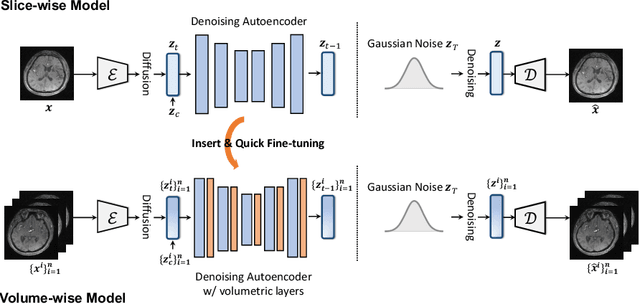
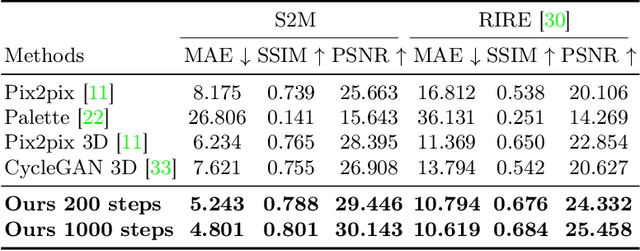


Abstract:Cross-modality medical image synthesis is a critical topic and has the potential to facilitate numerous applications in the medical imaging field. Despite recent successes in deep-learning-based generative models, most current medical image synthesis methods rely on generative adversarial networks and suffer from notorious mode collapse and unstable training. Moreover, the 2D backbone-driven approaches would easily result in volumetric inconsistency, while 3D backbones are challenging and impractical due to the tremendous memory cost and training difficulty. In this paper, we introduce a new paradigm for volumetric medical data synthesis by leveraging 2D backbones and present a diffusion-based framework, Make-A-Volume, for cross-modality 3D medical image synthesis. To learn the cross-modality slice-wise mapping, we employ a latent diffusion model and learn a low-dimensional latent space, resulting in high computational efficiency. To enable the 3D image synthesis and mitigate volumetric inconsistency, we further insert a series of volumetric layers in the 2D slice-mapping model and fine-tune them with paired 3D data. This paradigm extends the 2D image diffusion model to a volumetric version with a slightly increasing number of parameters and computation, offering a principled solution for generic cross-modality 3D medical image synthesis. We showcase the effectiveness of our Make-A-Volume framework on an in-house SWI-MRA brain MRI dataset and a public T1-T2 brain MRI dataset. Experimental results demonstrate that our framework achieves superior synthesis results with volumetric consistency.
Align, Adapt and Inject: Sound-guided Unified Image Generation
Jun 20, 2023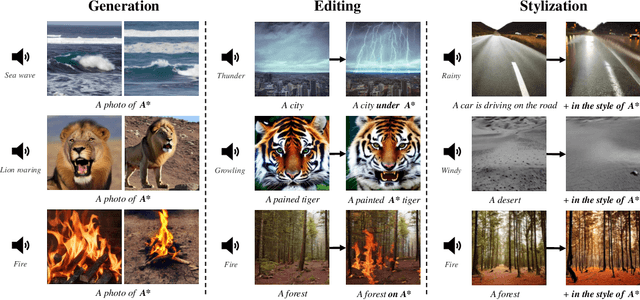

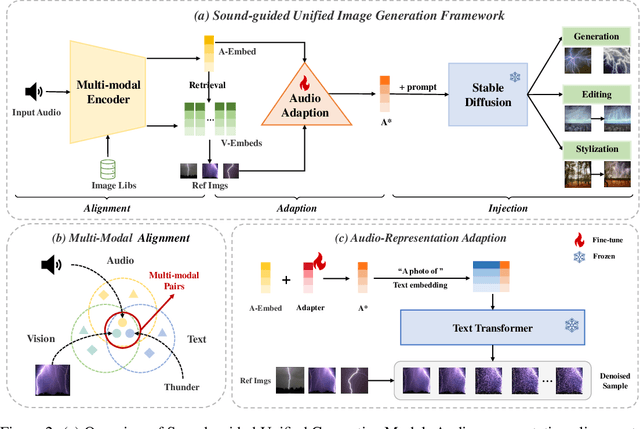

Abstract:Text-guided image generation has witnessed unprecedented progress due to the development of diffusion models. Beyond text and image, sound is a vital element within the sphere of human perception, offering vivid representations and naturally coinciding with corresponding scenes. Taking advantage of sound therefore presents a promising avenue for exploration within image generation research. However, the relationship between audio and image supervision remains significantly underdeveloped, and the scarcity of related, high-quality datasets brings further obstacles. In this paper, we propose a unified framework 'Align, Adapt, and Inject' (AAI) for sound-guided image generation, editing, and stylization. In particular, our method adapts input sound into a sound token, like an ordinary word, which can plug and play with existing powerful diffusion-based Text-to-Image (T2I) models. Specifically, we first train a multi-modal encoder to align audio representation with the pre-trained textual manifold and visual manifold, respectively. Then, we propose the audio adapter to adapt audio representation into an audio token enriched with specific semantics, which can be injected into a frozen T2I model flexibly. In this way, we are able to extract the dynamic information of varied sounds, while utilizing the formidable capability of existing T2I models to facilitate sound-guided image generation, editing, and stylization in a convenient and cost-effective manner. The experiment results confirm that our proposed AAI outperforms other text and sound-guided state-of-the-art methods. And our aligned multi-modal encoder is also competitive with other approaches in the audio-visual retrieval and audio-text retrieval tasks.
RAPHAEL: Text-to-Image Generation via Large Mixture of Diffusion Paths
May 29, 2023



Abstract:Text-to-image generation has recently witnessed remarkable achievements. We introduce a text-conditional image diffusion model, termed RAPHAEL, to generate highly artistic images, which accurately portray the text prompts, encompassing multiple nouns, adjectives, and verbs. This is achieved by stacking tens of mixture-of-experts (MoEs) layers, i.e., space-MoE and time-MoE layers, enabling billions of diffusion paths (routes) from the network input to the output. Each path intuitively functions as a "painter" for depicting a particular textual concept onto a specified image region at a diffusion timestep. Comprehensive experiments reveal that RAPHAEL outperforms recent cutting-edge models, such as Stable Diffusion, ERNIE-ViLG 2.0, DeepFloyd, and DALL-E 2, in terms of both image quality and aesthetic appeal. Firstly, RAPHAEL exhibits superior performance in switching images across diverse styles, such as Japanese comics, realism, cyberpunk, and ink illustration. Secondly, a single model with three billion parameters, trained on 1,000 A100 GPUs for two months, achieves a state-of-the-art zero-shot FID score of 6.61 on the COCO dataset. Furthermore, RAPHAEL significantly surpasses its counterparts in human evaluation on the ViLG-300 benchmark. We believe that RAPHAEL holds the potential to propel the frontiers of image generation research in both academia and industry, paving the way for future breakthroughs in this rapidly evolving field. More details can be found on a project webpage: https://raphael-painter.github.io/.
Temporal Enhanced Training of Multi-view 3D Object Detector via Historical Object Prediction
Apr 03, 2023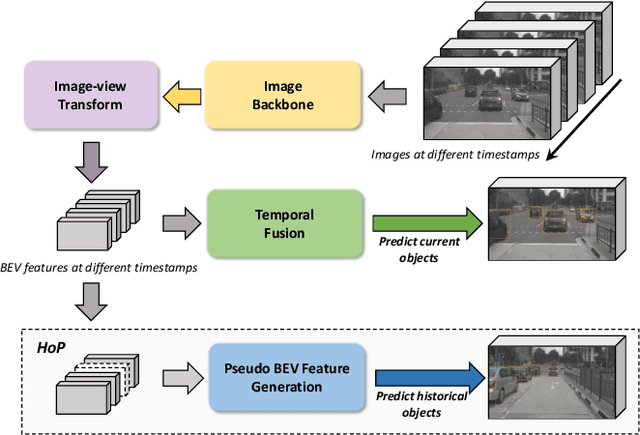

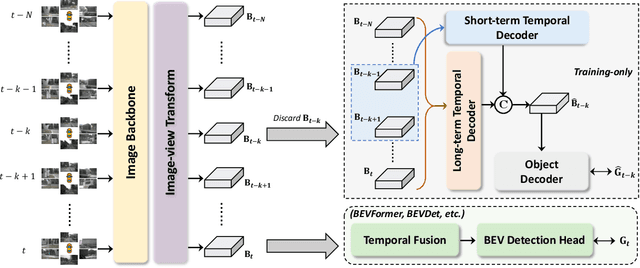

Abstract:In this paper, we propose a new paradigm, named Historical Object Prediction (HoP) for multi-view 3D detection to leverage temporal information more effectively. The HoP approach is straightforward: given the current timestamp t, we generate a pseudo Bird's-Eye View (BEV) feature of timestamp t-k from its adjacent frames and utilize this feature to predict the object set at timestamp t-k. Our approach is motivated by the observation that enforcing the detector to capture both the spatial location and temporal motion of objects occurring at historical timestamps can lead to more accurate BEV feature learning. First, we elaborately design short-term and long-term temporal decoders, which can generate the pseudo BEV feature for timestamp t-k without the involvement of its corresponding camera images. Second, an additional object decoder is flexibly attached to predict the object targets using the generated pseudo BEV feature. Note that we only perform HoP during training, thus the proposed method does not introduce extra overheads during inference. As a plug-and-play approach, HoP can be easily incorporated into state-of-the-art BEV detection frameworks, including BEVFormer and BEVDet series. Furthermore, the auxiliary HoP approach is complementary to prevalent temporal modeling methods, leading to significant performance gains. Extensive experiments are conducted to evaluate the effectiveness of the proposed HoP on the nuScenes dataset. We choose the representative methods, including BEVFormer and BEVDet4D-Depth to evaluate our method. Surprisingly, HoP achieves 68.5% NDS and 62.4% mAP with ViT-L on nuScenes test, outperforming all the 3D object detectors on the leaderboard. Codes will be available at https://github.com/Sense-X/HoP.
Transfer Heterogeneous Knowledge Among Peer-to-Peer Teammates: A Model Distillation Approach
Feb 06, 2020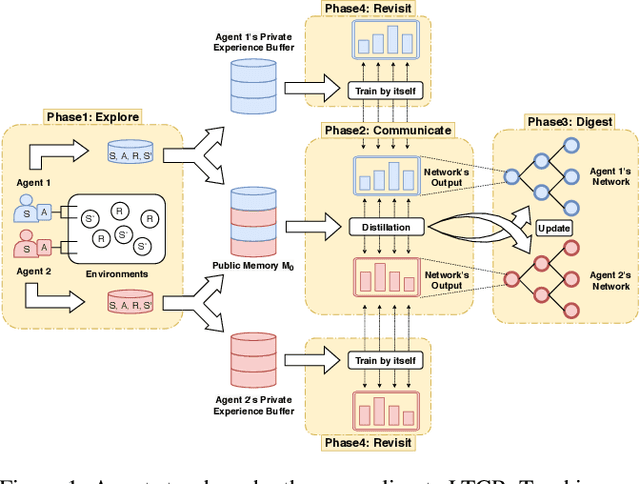

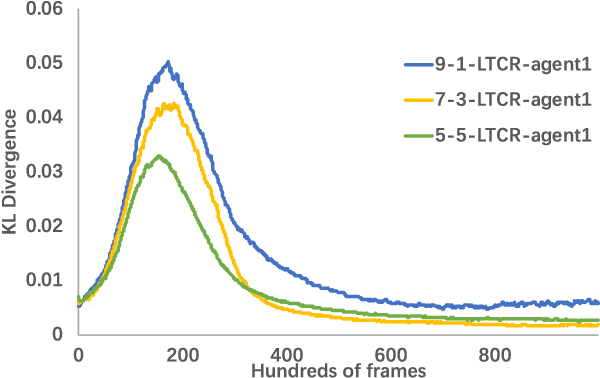

Abstract:Peer-to-peer knowledge transfer in distributed environments has emerged as a promising method since it could accelerate learning and improve team-wide performance without relying on pre-trained teachers in deep reinforcement learning. However, for traditional peer-to-peer methods such as action advising, they have encountered difficulties in how to efficiently expressed knowledge and advice. As a result, we propose a brand new solution to reuse experiences and transfer value functions among multiple students via model distillation. But it is still challenging to transfer Q-function directly since it is unstable and not bounded. To address this issue confronted with existing works, we adopt Categorical Deep Q-Network. We also describe how to design an efficient communication protocol to exploit heterogeneous knowledge among multiple distributed agents. Our proposed framework, namely Learning and Teaching Categorical Reinforcement (LTCR), shows promising performance on stabilizing and accelerating learning progress with improved team-wide reward in four typical experimental environments.
 Add to Chrome
Add to Chrome Add to Firefox
Add to Firefox Add to Edge
Add to Edge